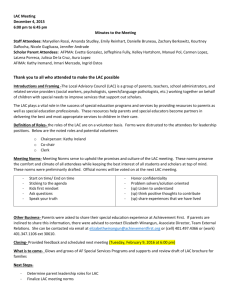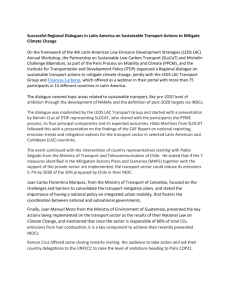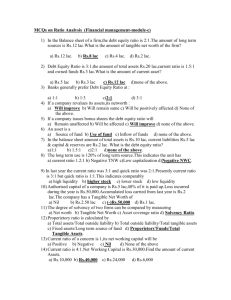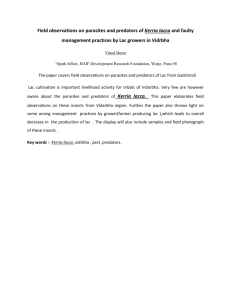FINANCIAL MANAGEMENT-Question for CAIIB exam
advertisement
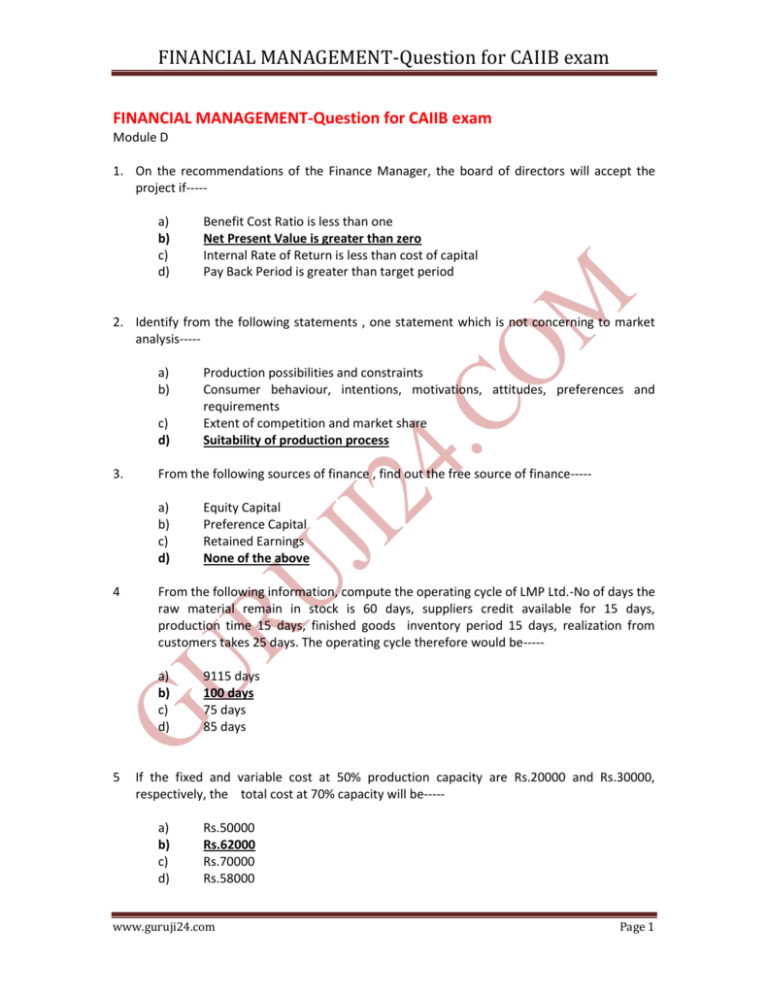
FINANCIAL MANAGEMENT-Question for CAIIB exam FINANCIAL MANAGEMENT-Question for CAIIB exam Module D 1. On the recommendations of the Finance Manager, the board of directors will accept the project if----a) b) c) d) Benefit Cost Ratio is less than one Net Present Value is greater than zero Internal Rate of Return is less than cost of capital Pay Back Period is greater than target period 2. Identify from the following statements , one statement which is not concerning to market analysis----a) b) c) d) 3. From the following sources of finance , find out the free source of finance----a) b) c) d) 4 Equity Capital Preference Capital Retained Earnings None of the above From the following information, compute the operating cycle of LMP Ltd.-No of days the raw material remain in stock is 60 days, suppliers credit available for 15 days, production time 15 days, finished goods inventory period 15 days, realization from customers takes 25 days. The operating cycle therefore would be----a) b) c) d) 5 Production possibilities and constraints Consumer behaviour, intentions, motivations, attitudes, preferences and requirements Extent of competition and market share Suitability of production process 9115 days 100 days 75 days 85 days If the fixed and variable cost at 50% production capacity are Rs.20000 and Rs.30000, respectively, the total cost at 70% capacity will be----a) b) c) d) Rs.50000 Rs.62000 Rs.70000 Rs.58000 www.guruji24.com Page 1 FINANCIAL MANAGEMENT-Question for CAIIB exam 6. Commercial paper , is an short term usance promissory note with fixed maturity period , issued by----a) b) c) d) Corporates & primary dealers All India financial Institutions (a) and (b) above None of the above 7. Surabhi Enterprises has given you the following information. The Re-order level 4000 units, minimum usage 300 units per week, minimum lead time 2 weeks and re-ordering quantity 2000 units. The maximum stock level of Surabhi Enterprises should be----a) b) c) d) 1900 units 5400 units 2900 units 4000 units 8. Susheel Hightech Ltd. are selling designer furniture to top customers. There is no direct competition for their product. They are negotiating a big order from one wealthy business magnate. While giving the quotation they should follow -----a) b) c) d) conversions cost pricing method market based pricing marginal cost pricing full cost pricing 9. Under cash budget system method, working capital is determined by ----a) b) c) d) ascertaining level of current assets ascertaining level of current liabilities finding cash gap after taking in to account projected cash inflows and outflows all of the above 10. IRR is calculated for one of the following purposes----a) b) c) d) 11. Working capital finance Pre-shipment finance Project finance Post shipment finance Actual Sales minus Break Even Sales means----a) b) c) d) Profit on sales Margin of safety sales Loss on sales Sales at which no profit or no loss is resulted www.guruji24.com Page 2 FINANCIAL MANAGEMENT-Question for CAIIB exam 12. Conversion cost is calculated on the basis of following formula----a) b) c) d) Direct Material plus Direct Labour Direct Material plus total overheads Direct Labour plus direct overheads Direct Material plus Administrative Cost 13. Under which method, the cost s are classified under fixed and variable cost and only variable costs are charged to products while fixed cost are written off to Profit and Loss Account. a) b) c) d) standard costing Marginal Costing Absorption costing Job costing 14. The following statements are pertaining to Letter of Credit (LC). One of the statements is wrong. Choose the wrong statement a) All letters of credit in India relating to the foreign trade are subject to provisions of "Uniform Customer and Practice for Documentary Credit" (UCPDC). b) The provisions of UCPDC have the status of law c) The parties to a LC bind themselves to UCPDC provisions by specifically agreeing to do. d) The UCPDC provisions help to arrive at unambiguous interpretation of terms used in LC 15. Which of the following is not part of working capital management? a) b) c) d) credit period to buyers proportion of current assets to be financed by long term debt dividend payout cash credit limit 16. In an operating cycle which of the following is not there a) b) c) d) acquisition of raw material acquisition of power acquisition of consumables conversion of raw material into work-in-progress 17. A low current assets ratio implies one of the following a) b) c) d) greater liquidity & lower risk poor liquidity & higher risk greater liquidity & greater risk poor liquidity & lower risk www.guruji24.com Page 3 FINANCIAL MANAGEMENT-Question for CAIIB exam 18. Financing temporary current assets with short term finance and permanent current assets with long term finance refers to a) b) c) d) matching approach conservative approach casual approach conservative approach 19. The formula for Economic Order Quantity(EOQ) is------ ( A= stock usage, C = cost of ordering, H= cost for holding stock per unit) a) b) c) d) √2AC/H √2ACH √2CH/A √AH/2C 20. If a buyer of goods gets a discount of 1.5% on a supply of Rs. 100 , if the amount is paid within 10 days where the normal credit period is 50 days. What is the annualized benefit to the buyer if he pays within 10 days. a) b) c) d) 21. 12.75% 13.69% 14.21% 13.65% which of the following is not a risk involved in carrying inventory a) b) c) d) obsolescence of the product physical deterioration in the goods price fluctuation in the product increase in the price of raw material 22. Factoring means b) c) d) e) another entity buys your debts another entity buys your credits another entity loans an amount to you none of the above www.guruji24.com Page 4 FINANCIAL MANAGEMENT-Question for CAIIB exam Question 1: GHI Ltd. manufacturers two products :Product G and Product H. The Variable cost of the manufacture is as follows: Direct Material Direct Labour (Rs.6 per hour) Variable Overhead Product G 3 18 4 Product H 10 12 4 Product G sells for Rs.40 and Product H at Rs.30. During the month of January, the Company is having only 21000 of direct labour. The maximum production capacity of Product G is 5000 units and Product H is 10000 units. From the above facts, answer the following: I. The contribution from Product G and H together is----a) b) c) d) Rs.32 Rs.19 Rs.27 Rs.40 II. The contribution per labour hour from Product H is----e) f) g) h) Rs. Rs. Rs. Rs. 4 2 3 5 III. The contribution per labour hour from Product G is----a) b) c) d) Rs.2 Rs.5 Rs.15 Rs.3 IV. The company can maximize profit if it can choose one of the following combination e) f) g) h) Product G- 3500 units and Product H -5250 units Product G- 5000 units and Product H -3000 units Product G- 4500 units and Product H -6000 units Product G- 4000 units and Product H -4500 units www.guruji24.com Page 5 FINANCIAL MANAGEMENT-Question for CAIIB exam Question 2: A Company producing a single product sells it at Rs. 100 each. The marginal cost of production is Rs.60 each and fixed cost is Rs.40000. Answer the following questions from this information: I. The amount of sales to earn a profit of Rs.50000 a) Rs.225000 b) Rs.125000 c) Rs.500000 d) Rs.90000 II The new break even sales if sales price is reduced by 10% a) b) c) d) Rs.100000 Rs.120000 Rs.90000 Rs.110000 Question 3: Three Investment projects have the following net cash flows. Decide which of them should be accepted using the payback period method. YEAR PROJECT A PROJECT B PROJECT C Project D 0 (10000) (15000) (20000) (30000) 1 5000 5000 10000 0 2 5004 5000 10000 0 3 20000 5000 4000 100000 4 1000 10000 2000 120000 5 5000 60000 a) b) c) d) www.guruji24.com Project D Project A Project C Project B Page 6 FINANCIAL MANAGEMENT-Question for CAIIB exam Question 4: The cash flow in respect of two projects is given below. The cost of capital is 12% , the discount factor of 12% is also given. Year Project A Project B 0 1 2 3 4 5 (200) 60 60 60 60 60 (300) 100 100 90 70 70 Discount Factor Discount Factor @ 12% @ 16% 1 1 0.8929 0.8620 0.7972 0.7431 0.7118 0.6406 0.6355 0.5522 0.5674 0.4761 Answer the following question using the above information. I What is the NPV of Project A (in Rs.) a) b) c) d) II What is the NPV of Project B (in Rs.) a) b) c) d) III 260.28 300 17.27 71 What is the Profitability Index of Project A a) b) c) d) IV 216.29 16.29 200 182.24 1.30 1.08 1 0.91 What is the Profitability Index of Project B a) b) c) d) 0.86 1 1.06 1.23 www.guruji24.com Page 7 FINANCIAL MANAGEMENT-Question for CAIIB exam V What is IRR of Project A a) b) c) d) 15.24% 14.24% 16.24% 14.50% Question 5: The following is the information of XYZ Ltd for last 2 years (Rs. in Lakh). Profit before Tax Tax Profit after Tax Dividends Retained Earnings 2005 68 34 34 28 6 2004 83 41 42 27 15 Difference 1 (9) How the above information is shown in the cash flow statement----a) b) c) d) At the sources column Rs.34 Lakh will be shown on account of Profit from operations and on uses column dividend payment of Rs. 28 Lakh will be shown At the sources column Rs.6 Lakh will be shown on account of Profit from operations and on uses column nothing is shown At the sources column nothing is shown on account of Profit from operations and on uses column Rs.9 Lakh is shown At the sources column nothing is shown on account of Profit from operations and on uses column Rs.8 Lakh is shown CASELET Read the following and answer Cost / unit Raw material 50 Direct labour 20 Overheads 40 Total cost 110 No. of units No. of units Sold on credit www.guruji24.com 10,000 8000 Page 8 FINANCIAL MANAGEMENT-Question for CAIIB exam Average raw material in stock : 1 month Average work in progress : ½ month Average finished goods in stock : ½ month Credit by supplier Credit to debtor Take 1 year = 12 months : 1 month : 2 months 1. Investment of working capital in raw material inventory is a) 41666 b) 50000 c) 33333 d) 10000 2. Investment in working capital for finished goods is a) 45833 b) 49090 c) 56453 d) 50000 3.current assets in respect of debtors a) 174541 b) 146666 c) 152500 d) 154326 www.guruji24.com Page 9 FINANCIAL MANAGEMENT-Question for CAIIB exam MCQs on Module B study of financial statements 1)A project costs Rs.16,000.The estimated annual cash inflows during its 3 year life are Rs.8,000, Rs.7,000 and Rs.6,000 respectively.What will be the pay-back period? a) 2 years b) 2.5 years c) 3 years d) 4 years 2) Cost of a project is Rs.12,000 annual cash inflows Rs.2,000 life 8 years & cost of Capital is 10%.If the present value of Re.1received annually for 8 years at 10% rate is 5.3349,calculate the present value index. a) 0.50% b) 0.60% c) 0.89% d) 0.75%. 3) A project which costs Rs.1,20,000 is expected to yield total earnings after depreciation and tax of Rs.60,000 over 3 years.The scrap value of the project after 3 years has been calculated at Rs.20,000.Calculate the average return of investment. a) 10% b) 20% c) 30% d) 25%. 4) A project of Rs.20,00,000 yielded annually profit of Rs.3,00,000 after depreciation at 12.5% and is subject to income tax at 50%.Calculate pay-back period? a) 2years b) 3years c) 5years d) 4years. 5) Profit maximization is a a) Short term concept b) long term concept c)both d) none of the above 6) Wealth maximization is a a) Short term concept b) long term concept c) either a or b d) both a& b. 7) Criterion for payback period a) Accept PBP>target period b) Accept PBP<target period c) Accept PBP=target period d) none of the above. 8) Criterion for accounting rate of return a) Accept ARR>target rate b) Accept ARR< target rate c) Accept ARR=target rate. d) none of the above. www.guruji24.com Page 10 FINANCIAL MANAGEMENT-Question for CAIIB exam 9) Criterion for Net Present Value a)Accept NPV>0 b) Accept NPV<0 c) Accept NPV=0 d) none of the above . c) Accept BCR=1 d) none of the above. 10) Criterion for IRR(Internal Rate of Return) a) Accept IRR>Cost of capital b) Accept IRR <Cost of capital c) Accept IRR= Cost of capital d) none of the above. 11) Criterion for benefit cost ratio a) Accept BCR>1 b) Accept BCR<1 12) Common size statements are a)Financial Statements that depict financial data in the form of vertical percentages. b) Financial Statements that depict financial data in the form of horizontal percentages c) All financial statements d) none of the above. 13) Horizontal Analysis is a)Changes in financial statements b) percentage analysis of increase & decrease in corresponding items in comparative financial statements. c) Financial statements which depict financial data. d)none of the above. 14) Fund Flow is a) Sources & Uses statement b) Sources Statement c) Uses Statement d) none of the above. 15) Economic Income is defined as a) Change in wealth b) Change in income c) Change in profit d) none of the above. www.guruji24.com Page 11 FINANCIAL MANAGEMENT-Question for CAIIB exam MCQs on Ratio Analysis (Financial management-module-c) 1) If a company revalues its assets,its networth : a) Will improve b) Will remain same c) Will be positively affected d) None of the above. 2) If a company issues bonus shares the debt equity ratio will a) Remain unaffected b) Will be affected c) Will improve d) none of the above. 3) An asset is a a) Source of fund b) Use of fund c) Inflow of funds d) none of the above. 4) In the balance sheet amount of total assets is Rs.10 lac, current liabilities Rs.5 lac & capital & reserves are Rs.2 lac .What is the debt equity ratio? a)1;1 b) 1.5:1 c)2:1 d)none of the above. 5) The long term use is 120% of long term source.This indicates the unit has a) current ratio 1.2:1 b) Negative TNW c)Low capitalization d)Negative NWC. 6) In last year the current ratio was 3:1 and quick ratio was 2:1.Presently current ratio is 3:1 but quick ratio is 1:1.This indicates comparably a) high liquidity b) higher stock c) lower stock d) low liquidity 7) Authorised capital of a company is Rs.5 lac,40% of it is paid up.Loss incurred during the year is Rs.50,000.Accumulated loss carried from last year is Rs.2 lac.The company has a Tangible Net Worth of a) Nil b) Rs.2.50 lac c) (-)Rs.50,000 d) Rs.1 lac. www.guruji24.com Page 12 FINANCIAL MANAGEMENT-Question for CAIIB exam 8) The degree of solvency of two firms can be compared by measuring a) Net worth b) Tangible Net Worth c) Asset coverage ratio d) Solvency Ratio. 9) Properietory ratio is calculated by a) Total assets/Total outside liability b) Total outside liability/Total tangible assets c) Fixed assets/Long term source of fund d) Properietors’Funds/Total Tangible Assets. 10) Current ratio of a concern is 1,its net working capital will be a) Positive b) Negative c) Nil d) None of the above 11) Current ratio is 4:1.Net Working Capital is Rs.30,000.Find the amount of current Assets. a) Rs.10,000 b) Rs.40,000 c) Rs.24,000 d) Rs.6,000 12) Current ratio is 2:5.Current liability is Rs.30000.The Net working capital is a) Rs.18,000 b) Rs.45,000 c) Rs.(-) 45,000 d) Rs.(-)18000 13) Quick assets do not include a) Govt.bond b) Book debts c) Advance for supply of raw materials d) Inventories. 14) The ideal quick ratio is a) 2:1 b) 1:1 www.guruji24.com c) 5:1 d) None of the above Page 13 FINANCIAL MANAGEMENT-Question for CAIIB exam 15) A very high current ratio indicates a) High efficiency c) position of more long term funds b) flabby inventory d) b or c 16) Financial leverage means a) Use of more debt capital to increase profit b) High degree of solvency c) Low bank finance d) None of the above 17) The capital gearing ratio is high for a company.It indicates a position of a) Low debts b) high preference capital c) high equity d) low debt equity ratio. 18) In the Balance sheet of a firm,the debt equity ratio is 2:1.The amount of long term sources is Rs.12 lac.What is the amount of tangible net worth of the firm? a) Rs.12 lac. b) Rs.8 lac c) Rs.4 lac. d) Rs.2 lac. 19) Debt Equity Ratio is 3:1,the amount of total assets Rs.20 lac,current ratio is 1.5:1 and owned funds Rs.3 lac.What is the amount of current asset? a) Rs.5 lac d)none of the above. b) Rs.3 lac c) Rs.12 lac 20) Banks generally prefer Debt Equity Ratio at : a) 1:1 www.guruji24.com b) 1:3 c)2:1 d) 3:1 Page 14



